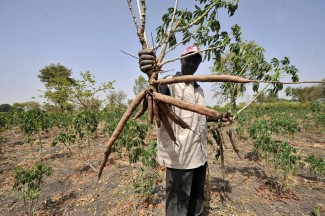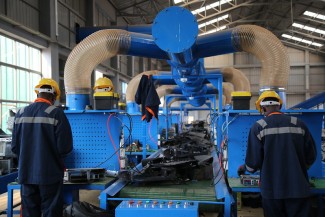Ambition was plentiful at last year’s climate conference, but outcomes can best be described as mixed when it comes to climate finance. While some eye-catching pledges made headlines, for the majority of the world where climate change impacts are a constant reality, these can still feel far-removed, not to mention entirely inadequate in scale against the estimated $60-90 trillion of investment needed over the next 15 years.
Shifts in narrative must now be backed up with material change. We are already playing catch-up on climate finance, with a 2009 pledge by wealthier countries to raise $100 billion a year to support least developed countries to meet Paris Agreement goals still not met. As we edge closer to COP27, we are still yet to see the money and serious conversations are needed on whether current financial mechanisms can deliver necessary changes or whether more fundamental change is required to address the inequality of the global economic system and deliver climate justice. Existing financial flows are failing to reach adaptation efforts on the ground. As more frequent disasters strike, we continue to see communities locked out from the funds and resources they desperately need – and yet the loss and damage facility which could have addressed this was still not approved at COP26. Frontline communities are our first responders, and if we cannot get money to them directly to bolster their resilience and their ability to adapt, then our approach to climate finance is failing.
Trade is a critical part of on the ground adaptation efforts that must also be considered, specifically local trade amongst small and medium enterprises which are impacted head-on by climate emergencies. We are seeing communities already vulnerable to shocks affected not only in terms of their resources getting destroyed or depleted but also due to a lack of support systems when this happens. There is an added dimension to this, in which we are now moving into a phase where disasters happening in one part of the world have a ripple effect, impacting global supply chains. We saw this happen on a major scale in Thailand over ten years ago when floods hit industrial parks destroying businesses and livelihoods. The floods caused approximately $45bn in economic damages and supply chain implications were felt globally. However, it seems we have still not learned our lesson and with each new crisis that strikes, impacts reverberate across the world.
There are two key aspects to improving local access to resources. First, to enable genuinely locally-led adaptation efforts, communities must be trusted to use grants and invest funds where they are most needed. International institutions and private sector decision-making must embrace a new ethos with this approach at its heart.
The work done at SouthSouthNorth in South Africa to increase resilience and reduce vulnerability in Namakwa District in the Northern Cape and Mopani District in Limpopo is a clear example of this. This investment, drawn from the Adaptation Fund, showed how investing in locally-led initiatives can make a tangible difference to people’s livelihoods and demonstrated the importance of building administrative capacity for the successful implementation of future Community-Based Climate Change Adaptation projects.
Secondly, improving local-level access to climate finance requires addressing problems arising from working within traditional fiduciary and reporting requirements. This will require a reimagining of what success looks like: impact cannot be measured by simply following a strict definition of return on investment.
From the perspective of the insurance industry, the challenge is to close the financial protection gap - to expand the limited insurance markets in developing countries, and to encourage development finance institutions to leverage insurance risk management capacity and capabilities properly. We are currently trapped in a cycle of disaster management, rather than a proactive approach to managing risks and building longer-term resilience. Over the last 20 years, the insurance industry has paid out an average of $55 billion per year of losses following catastrophic events. However, most of these payments have been in developed markets as many developing nations still do not have mature insurance markets which can guarantee shock absorption and resources to ensure speedy recovery in the event of damage caused by flooding, tsunamis, or cyclones. Ultimately what emerges in most developing countries is the diversion of development finance to disaster response.
The development of effective methods of risk management, which remains undervalued in present discussions, is key. Building true long-term resilience will require a greater focus on the true cost of delayed action and consequently a shift away from the provision of payments in response to disasters into more strategic development of early warning systems, insurance, and social security nets. This will require stepping outside the bounds of business-as-usual, with an enhanced focus on public-private partnerships that deliver.
On the margins of COP26, we started to witness this evolution with the Vulnerable 20 (V20) Group of 55 climate-vulnerable Ministers of Finance highlighting the importance of the financial protection gap and announcing a partnership with the Insurance Development Forum (IDF) on Risk and Resilience Analytics. The expectation is that using insurance-based methodologies, tools and experience, countries will be able to develop greater local ownership of risk analysis, which is an essential foundation for mainstreaming climate and disaster risk finance and with potentially profound implications in terms of mobilising private capital. The hope is that this is continued and capitalised on at COP27.
Crucially, any strategic approach to reducing risk and creating resilience must centre inclusivity, equity and empowerment. Across the board, a fundamental disconnect remains between many of the climate finance conversations which form part of the COP process and of trade negotiations and the knowledge and experiences of those adapting to climate change who in many instances are already driving the development of solutions on the ground.
A more collaborative approach to the climate finance debate is urgently needed, where voices from the global south are present in negotiating spaces. From the UNFCCC negotiations to the high-level conversations and trade negotiations, their successes hinge on their ability to positively impact the lives of people on the ground and contend with the impacts of climate change. Communities are getting rightly frustrated with the slow pace of progress and there is a need to return to basics with a fairer approach to ensure the work being done is relevant to the challenges people are facing today. This must bring in all voices equally, and specifically, those of women and minorities who are disproportionately affected by climate change, yet chronically under-represented in conversations about how it can be addressed and consequently in the delivery of solutions.
As the UK concludes its COP Presidency and we look towards COP27 in Sharm El-Sheikh, there is an opportunity to do more and better to deliver progress on climate finance beyond words and headlines. The UK must use its leverage to step up and lead in mobilising major segments of the global financial sector to invest in resilience and collaborate with the incoming envoy. The appointment of veteran economist Mahmoud Mohieldin as UN Climate Change High-Level Champion for Egypt sends a strong signal that COP27 will focus on engagement with the private sector and financial institutions. The opportunity for success is there, but it will only be achieved if it is done in a way that allows for systematic locally-led, innovative, and inclusive approaches that put the voices of those on the front line at the heart of solutions and as equal partners.
Photo by SouthSouthNorth
If you would like to reuse any material published here, please let us know by sending an email to EIF Communications: eifcommunications@wto.org.



